Software Needs Cycle for CRM: CRM Needs Analysis
As any business grows in size, and takes on more customers, it will find itself with greater customer relationship management (CRM) needs.
Though pen-and-paper methods or even Excel spreadsheets are fine for a business that’s just starting out, companies with an expanding customer base need CRM software to help keep track of contact details and other important information.
If you don’t have a CRM system, or you don’t continually upgrade the one you currently use, you quite simply won’t be able to match up to your competitors as you grow in size.
Here at Software Advice, we talk to thousands of small-to-midsize businesses (SMBs) every year about their CRM software needs, which gives us a unique ability to perform a CRM needs analysis to determine which aspects of CRM are most important to SMBs as they grow.
We’ve analyzed that data in order to create our first-ever software Needs Cycle for CRM, which will help SMB buyers like you figure out which CRM features are the most important to focus on as you grow in size.
Using our data, we’ve broken down the nine most important features discussed on our CRM software page and sectioned them into what you’ll need to start your CRM process, what you’ll require to grow as a business using CRM and what you’ll utilize to optimize your CRM operations.
Here’s what we’ll cover:
3 CRM Features You Need to Start
3 CRM Features You Need to Grow
3 CRM Software Features You Need to Optimize
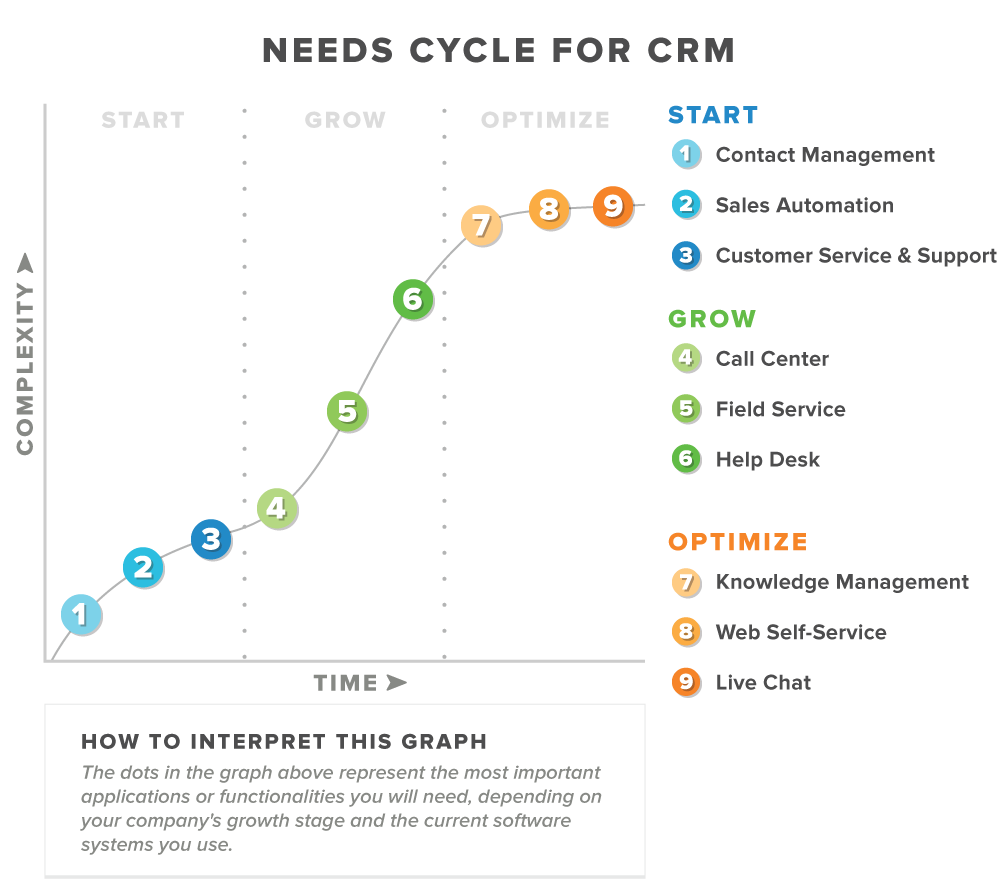
Methodology: To create this Needs Cycle, we looked at all Software Advice advisor interactions with CRM software buyers from the last 12 months (over 8,000 interactions in all). From these interactions, we calculated the most requested CRM software applications in each of three key business sizes to determine the stage at which different applications reach peak adoption.
3 CRM Features You Need to Start
This section is for businesses who are just starting their CRM software journey. These are businesses with 1 to 50 employees that need the basic features required to help set up a CRM system.
1. Contact Management
What it does: Contact management tracks and organizes important information about the individuals and organizations connected to an SMB’s business. It provides a centrally located, accessible database where you can store all of the important information about your customers, clients, prospects, leads etc., including names, phone numbers, email addresses, preferred method of contact and notes from each interaction with that contact.
Why you need it to start: Contact management is the most basic function of CRM software. It is our number one feature that defines a system as being in the CRM market for our CRM Frontrunners Quadrant, and it’s essentially a requirement for all the other features discussed in this Needs Cycle.
To put it simply, if you’re purchasing a CRM system, you’re buying software that features contact management as a key function. This feature is so fundamental to CRM software that it’s actually taken as a given by our advisors that contact management is a part of a buyer’s CRM request, and considered a necessity for 100 percent of companies getting started with CRM.
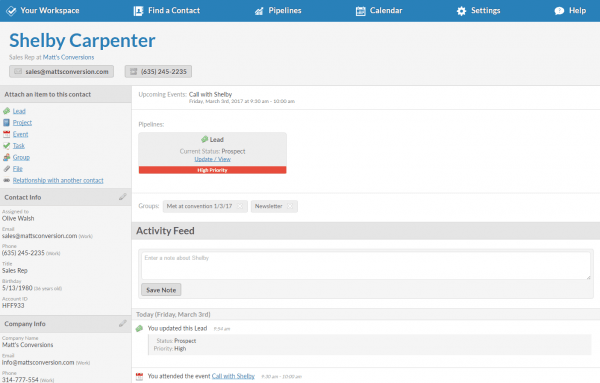
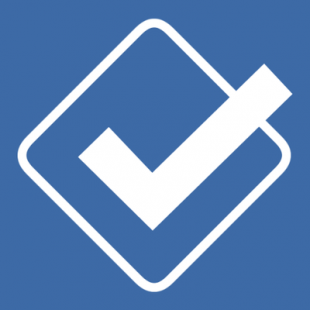
A contact in Less Annoying CRM
Key Considerations:
Make a list of the contact management needs you currently have, predict which ones you’ll require in the future and then research vendors in order to pick one that will provide all of your needs as you expand.
One of the key aspects of contact management is integration, so make sure that the system you purchase will allow you to connect those contacts with other software systems you may be using, like human resources or accounting.
2. Sales Automation
What it does: Sales automation organizes leads and prospects so that your sales team can track prior interactions with those contacts and obtain better guidance about next best actions.
Why you need it to start: The requests we received for sales automation functionality in CRM software came overwhelmingly (89 percent!) from small businesses just starting their CRM process. The reason for this is fairly simple—businesses need strong sales in order to make money, and sales automation helps improve sales.
Sales automation helps SMBs better organize and coordinate their sales teams and processes, so that you can turn a ragtag group of individual salespeople into a coordinated team that works together for the best interests of the company rather than competing with one another.
Using sales automation software, you’ll also be able to get reports on your sales team’s successes and failures that will give you greater awareness of what processes are and are not working, and provide you with analytical insight that will help you predict future sales cycles.
In short, sales automation will help you prepare for the future growth and expansion of your business in terms of both size and profit.
Percentage of Requests for Sales Automation at Different Stages of the CRM Software Needs Cycle
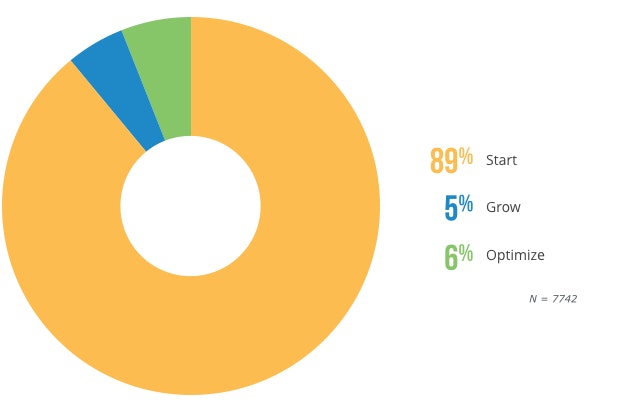
Key Considerations:
To choose the right sales force automation software for your company, consider what type of sales you’re in—B2B, B2C, direct selling, channel selling etc.—in order to vet products that are specifically geared towards your business model.
If you’re interested in having your sales and marketing teams working together to make the most of your marketing leads, then you might consider a robust CRM system that will provide you with integration between sales and marketing, including sales enablement tools.
3. Customer Service & Support
What it does: Customer service and support software helps customer service representatives (CSRs, or “agents”) document, route, track, resolve and report on customer issues using a trouble ticketing system. This can greatly reduce the time required to resolve issues, resulting in more satisfied customers. The software will also provide you with reports and analytics about each agent’s performance.
Though these tools are sometimes referred to as “help desk software,” we define the two functions differently, as discussed in the help desk section below.
Why you need it to start: From previous research we’ve done into our customer service buyers, we know that many companies buy customer service software when they are scaling beyond general contact management and are in need of more specialized customer service features, such as trouble ticketing.
In essence, customer service and support software is the feature used by companies to complete their first wave of CRM implementation before they prepare to grow.
Customer service software increases agent accountability in the same way that sales automation software increases salesperson accountability, providing you with a close look at how your processes are or are not working. This will allow you to refine and perfect that process so that you’re ready to grow as a company and deal with a greater number of customer service and support requests.
When paired with sales force automation systems, customer support systems afford both the sales and the service organizations better transparency into customer data. This can provide benefits such as letting sales representatives know of any outstanding issues before making a call, or letting an agent know that repair parts are already ordered so that a customer does not double order parts.
Percentage of Requests for Customer Service & Support at Different Stages of the CRM Software Needs Cycle
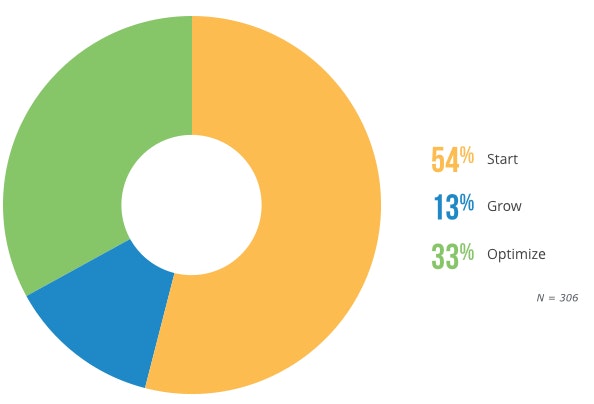
Key Considerations:
Though you may not need all of these features initially, it can be useful to know that some customer service support systems can be integrated with other enterprise applications such as service dispatch software (to enable on-site repairs) and inventory and cataloging systems (to ensure that exchange parts are in stock).
Make sure that your sales automation and customer service and support software integrate smoothly with one another, even if they aren’t part of the same system. By pairing the two together, both the sales and the service organizations will gain better transparency into your customers’ data.
3 CRM Features You Need to Grow
This section is for growing SMBs, with 51 to 100 employees, that are looking to refine their CRM processes to better align with their business strategy. The applications cited here are expected to build upon the foundation created in the “Start” stage.
4. Call Center
What it does: Call center software is an umbrella term for applications designed for use in either a formal or informal call center. It supports the agents whose job it is to assist customers over the phone, or via one of those other channels, as well as the supervisors who oversee the call center’s operations.
Why you need it to grow: Though a small business can get away with not having a dedicated call center, relying instead solely on online customer service applications, a growing business needs to have a dedicated call center.
In order for that call center to run smoothly, it requires software to automate processes that would take unwieldy amounts of time if they were handled by a manual switchboard.
The call center software tools that make this possible include automatic call distribution, interactive voice response, computer telephony integration and call center scripting, along with more general functions like workforce scheduling, monitoring and auto-dialing.
With these tools in your arsenal, you’ll be able to establish a successful call center to help meet your customers’ needs, which will allow you to continue your growth process without completely losing the personal touch you had as a smaller company.
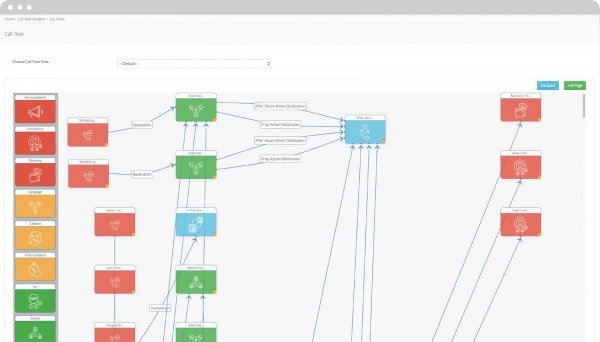

Convoso Cloud Contact Center’s call flow chart
Key Considerations:
Since call center software is so intimately tied into customer calls asking your company to resolve issues and complaints, you’ll want to make sure that this system is integrated with your customer service and support software.
Keep in mind the size and needs of your call center when you first purchase software, focusing on what you will have immediate use for. Be sure to research whether you can add on features and integrations as your company—and its call center—continues to grow.
5. Field Service
What it does: Field service software helps your business to schedule and track outside operations. For representatives, it will provide schedules, routes, customer information and information regarding necessary supplies and parts. In addition, managers can schedule outside agents and resources, track customer history and manage work orders.
Why you need it to grow: Not all companies will actually require field service capabilities, but any company that sends out representatives to deal with the public will need dedicated field service software if they’re going to grow and make deliveries or service/installation calls.
Field service software can help you literally grow the geographical base you cover, by streamlining your scheduling and tracking processes so that you can cover more territory, and it can help you to schedule more appointments in a given day in order to grow your business’ level of customer service satisfaction.
Using this software, you’ll be able to reduce scheduling and fuel costs (the software can schedule appointments more densely and reduce travel times through intelligent routing) as well as parts and inventory costs (the system will analyze history files to predict which parts will fail on what schedule).
The most important aspect of field service software (and what makes it part of customer relationships management) is that it can increase customer satisfaction in three ways: it can allow customers to pick convenient appointment times, provide more precise arrival times for technicians, and predict the tools and parts that a representative will require at an appointment.
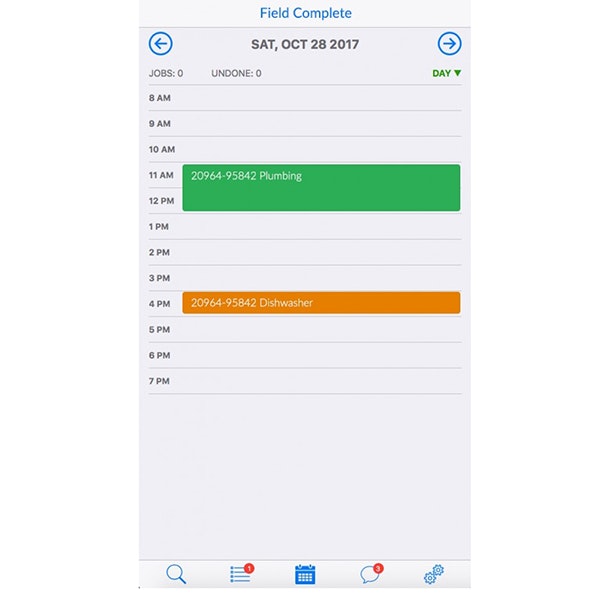
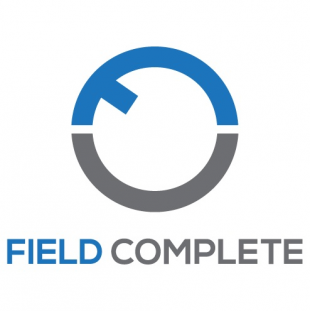
A scheduling page in Field Complete
Key Considerations:
Field service software can increase productivity and customer satisfaction, but can also increase the risk of over-scheduling representatives. This will decrease their effectiveness and make them more dissatisfied with their jobs, and it will also counteract the increases in customer satisfaction by making those representatives more likely to miss appointments.
You will almost certainly want mobile functionality for your field service software so that your representatives can check the system from tablets or smartphones while out in the field. Depending on the size of your operation you may also want to look into service dispatch software that will help you to centralize and automate how you schedule technicians going out into the field.
6. Help Desk
What it does: A help desk is the point of contact that provides technical IT support and assistance within an organization. Help desk software, then, features tools that enables those support processes to function more smoothly.
Sometimes, the term “help desk” is used interchangeably with “customer support and service,” but there is a key difference between the two as we define them—whereas customer support and service is about resolving external issues presented by customers, help desk is about resolving internal issues from employees within your company.
Because of this difference, the nature of help desk complaints tend to be closely tied to IT support and other forms of technical support.
Why you need it to grow: As your company grows, naturally so will your number of employees, as well as the amount and variety of software that those employees will use (this entire needs cycle is an example of that).
However, in order to keep that software functioning properly, you’ll need a rock-solid IT department, and that department can only help your employees efficiently if they have access to help desk software that lets them meet employees’ needs.
Help desk management software will automate the issue resolution process using an issue tracking system. This core functionality increases efficiency and organization by creating trouble tickets that are associated with a contact’s profile. These tickets will allow the help desk to track the progress and ultimate resolution of an issue, as well as providing managers with an overview of the entire team’s work.
As we discuss in our help desk buyer’s guide, a fully-implemented help desk system can improve your business’ operations in five key ways:
Minimize employee work lags from unsolved tech issues
Automate issue triaging, escalation and prioritization
Reduce manpower costs through self-service
Identify and address recurring issues
Provide transparency into every service request from creation to resolution
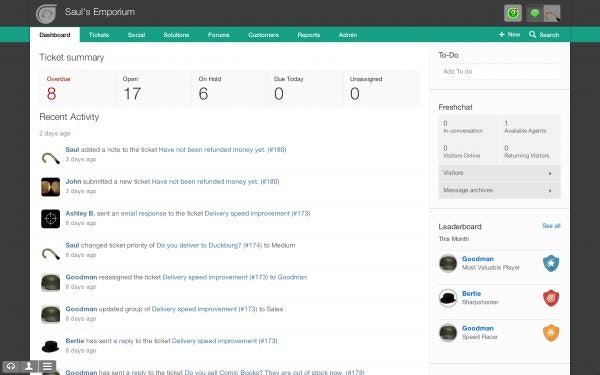

A ticket summary in Freshdesk
Key Considerations:
When shopping for help desk software, be sure that you’re specific with vendors about the type of system you’re looking for, in order to avoid confusion over the different meanings of the term “help desk.”
As your company grows even larger, an important aspect of your help desk system will be its integration with your knowledge management system, discussed in the following section.
3 CRM Features You Need to Optimize
This section is for established businesses looking to optimize their CRM processes in order to create the best possible customer experience. The applications cited here are expected to build upon the foundations created in the “Start” stage and developed in the “Grow” stage, and are most useful for businesses with more than 100 employees.
7. Knowledge Management
What it does: Knowledge management (KM) is a business process that formalizes the management and use of your business’ intellectual assets (such as your investments in brands, design, technology and creative works). KM promotes a collaborative and integrative approach to the creation, capture, organization, access and use of information assets, including the tacit knowledge of a business’ human resources.
KM software enables this process in that it takes your business’ raw data and transforms it into something usable. It does this by collecting data in a central knowledge base, contextualizing it and making it easily searchable, so that users can find the information they need on their own.
Why you need it to optimize: Any large-scale business deals with an overwhelming amount of data on a daily basis, and the larger you grow the more difficult it can get to turn that data into helpful information. If you want to optimize your business processes, you’ll need KM software to help you separate the signal from the noise amidst all of that incoming data so that you can create an efficient knowledge base.
A knowledge base is a specialized database that can be searched and browsed by your employees and your customers so that they can find answers to their own questions before they contact support agents. It is a foundational database that can be used for internal-facing functions (which is what we are discussing in this section) as well as customer-facing self-service (which we will discuss in the next section).
The more you grow as a business, the more questions your customers—and your employees—will have. KM software can help them find many of the answers on their own, which will streamline and optimize your customer service process.
Because this is a problem primarily faced by larger businesses, the majority of our buyers who were requesting KM software were in the optimization stage of their CRM journey.
Percentage of Requests for Knowledge Management at Different Stages of the CRM Software Needs Cycle
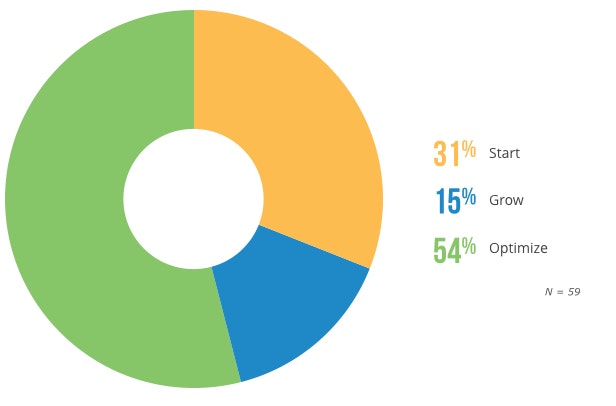
Key Considerations:
When considering the knowledge base that you want to build for your company, remember that you will want a repository that is internal-facing, so that agents can find quick answers to customer service requests, as well as one that is external-facing, so that customers can answer the simplest questions on their own (see the web self-service section, below).
Since you will have already built up an extensive CRM system by the time you are looking at knowledge management software options, make sure that you are able to properly integrate any KM software with the systems you already have in place.
8. Web Self-Service
What it does: Web self-service is a specialized type of knowledge management that is outward-facing, which allows customers to use your website to find answers to common questions on their own.
Why you need it to optimize: More than half of the buyers who were looking for web self-service came from those buyers in the optimization stage, because, like knowledge management, it is a problem primarily faced by larger businesses. Companies that are just starting, or just beginning to grow, will not have as many frequently asked questions that they can provide the answer to online, nor will they be as inundated with customer service requests.
Our previous research shows that the majority of consumers (65 percent) prefer to search for an answer online rather than through calling or emailing a company. Thus, implementing web self-service will not only be popular with your customers, but it will also decrease the demand for more expensive ways of answering questions (live phone agents, personalized emails, etc.).
Making your customers happy while gaining a competitive advantage and lowering the costs of providing support is an important part of optimizing your CRM process, which is why it can be found at this point on the Needs Cycle.
Percentage of Requests for Web Self-Service at Different Stages of the CRM Software Needs Cycle
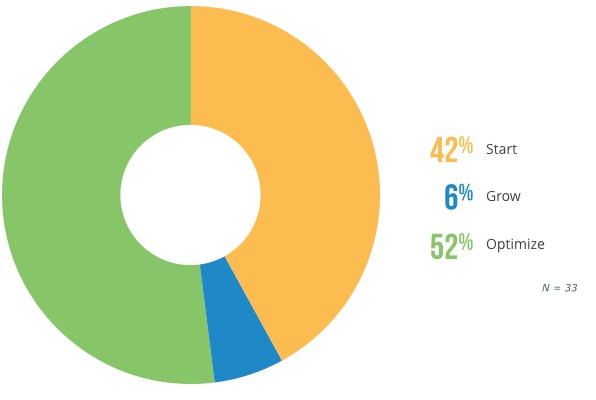
Key Considerations:
Web self-service software is offered in three different ways: 1) separately, as best-of-breed programs; 2) integrated within knowledge management, customer service, IT support and help desk platforms; and 3) as part of full-fledged CRM software suites. You’ll want to consider whether you want an independent program or one that’s an outgrowth of your current CRM system; either way, make sure that you can integrate it with the systems you already have in place.
Most web self-service functionality is provided through knowledge management software, so you will likely want to vet and select a vendor for both of these tools at the same time.
9. Live Chat
What it does: Live chat is a communication channel that allows customers and businesses to converse in real-time directly on a company’s website. It’s like a private Google Hangout/Facebook Message/Slack Channel between the customer and the business, typically appearing in the form of a small box or window on the company’s webpage. This conversation can be initiated by the customer, the company or both.
Why you need it to optimize: As you’ve probably noted from the sections on knowledge management and web self-service, optimizing your CRM system is all about streamlining customer support processes. Live chat is another way that you can achieve this, by providing your customers with a quick, easy way to get answers to their questions directly on your website (just as they can with web self-service).
Live chat systems tend to be extremely flexible and customizable, such that you can set a chat window to pop up for each and every visitor or only under specific circumstances (such as customers who have spent over a specific amount of time on one particular page or visitors who go back and forth several times between two different product pages).
Percentage of Requests for Live Chat at Different Stages of the CRM Software Needs Cycle
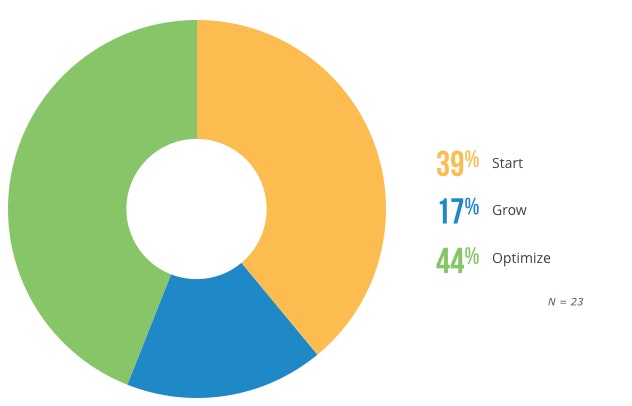
Key Considerations:
Some live chat platforms are intended for general use, while others are tailored to specific business models and/or industries, so check out several vendors to see which product is the right fit for your business.
Live chat tends to be a particularly feature-rich communication channel, with a large variety of functionality that you can customize for your specific, individual needs.
Conclusions & Next Steps
Be sure to keep this entire map of the Needs Cycle in your head as you start your CRM journey. The majority of CRM software is packaged by vendors in large software suites, so if you know that you’ll want field service and live chat as your company grows, you may want to purchase contact management from a vendor who can add on those features down the line as integrations.
Hopefully, you now have a clearer picture of the types of CRM applications you’ll need at each stage of your business’ growth. This should make you better able to assess the CRM options available to you and make the right purchase choice for your company, but if you’d like some more help with your journey, here’s a few easy next steps you can take:
Fill out this free questionnaire with some basic information about your business and yoru CRM needs to get a customized list of CRM systems based on your specific needs.
Call our software advisors at (844) 688-1783 for a free phone consultation that can give you a short-list of CRM products based on the advisors’ expertise in talking to thousands of SMBs like yours.
Check out our FrontRunners® Quadrant for Customer Relationship Management to view the top CRM products based on users’ reviews of each product’s value and capability.
Visit the CRM product listing page to read actual user reviews from your fellow SMBs, so you can find out which systems they used to fulfill the needs of their own CRM journeys.